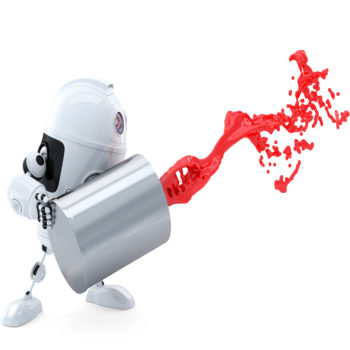What Role is Artificial Intelligence Set to Play in Creative?
by Lindsay Rowntree on 30th Aug 2017 in News

Artificial Intelligence is one of the latest buzzwords to hit the creative sector. In the tradition of those gone before it, the likes of ‘big data’ and ‘growth hacking’, AI has been billed as having transformational capabilities, and able to revolutionise business and marketing, writes Robert Berkeley, president, Express KCS, exclusively for ExchangeWire. Accenture estimates that an AI revolution could work to double the annual economic growth rates of 12 of the largest developed countries by 2035.
To the relatively uninitiated, AI is more commonly associated with areas like robotics and complex analytics. It wouldn’t, therefore, be unreasonable to assume that a technology typically associated with complex and intelligent processes could not in itself be creative or automate creativity. Brands and agencies rely on creativity to be human and personal in its nature. It is, and should be, done by people. However, I believe that, despite its somewhat overhyped nature, AI can play a crucial role in improving creativity.
The challenge of this vision is clear: technology can lack emotion. Creatives are right to be somewhat sceptical of the role it can play. Intelligent robots can be designed to reflect fashions and learn from experiences rather than defining them as creatives do. Empathy is key to producing good ideas that engage markets, so encouraging technology uptake in this space is also likely to prove challenging amongst creative professionals. The concern with the introduction of any new technology is always going to be jobs, particularly because AI is lowering human input in other sectors.
AI is already being used across the marketing and advertising industries, with very positive results. Ad fraud, for example, can be detected using AI; which is particularly valuable to brands looking to ensure their ad spend is going to the right places. It is also being used in developing search marketing strategies and programmatic advertising to detect opportunities.
Google has done a lot of experimenting with AI, and has shown off its computers ability to caption images, and even dream of new and unusual ideas such as animals in clouds! The world of Google aside though, AI has the potential to play a crucial role in creativity, enabling designers to drive significant improvements in their quality of output.
From a process management perspective, automating parts of creative work would enable creative teams to dedicate more time to ideas, content generation, and design. At Express KCS we’ve started to see AI be used to suggest new ideas and develop very simple work, such as basic ad templates, that would typically be seen as a menial design task by expert design teams. By automating the production of the most basic ads, such as those with heavy amounts of text or simply small in size, brands and agencies can avoid deskilling design teams and keeping them focused on more complex work.
The well-known phrase that 50% of marketing works, but we just don’t know which 50% seems to ring less true every day. The more intelligent our marketing becomes, the less untraceable our work. AI is already being used as part of predictive marketing, and it can be particularly valuable in driving and evaluating creative processes. Identifying precisely what works and what doesn’t is key for creatives to demonstrate the value of their work and to ensure what they are doing is delivering the desired results. Being able to recognise and react to patterns in data (which can be as simple a metric as click-through rates), and connecting this to ideas that ‘work’ will become evermore crucial to the creative process. Particularly as marketing and advertising budgets are squeezed, being able to identify where value lies is essential.
In my view, the future role of AI in creative is that of delivery of insightful options. The aim is not to deskill creatives, but make them even better and more productive at their jobs, while automating the more mundane work (such as versioning) and decision-making (such as element repositioning or template selection). By integrating AI-driven performance monitoring, brands and agencies can identify intelligent targeting, types of design that are most likely to spark specific calls to action, and achieve the highest possible conversion rates.
In short, the role AI can and will play in creative is not one of job replacement but that of an enabler of better creativity. From perfecting ads, through to improved targeting, I want to see greater integration of AI into process management. Pressure on advertising and marketing to deliver results is always high, and AI presents an opportunity for these creative departments to not just deliver better results, but demonstrate their value along the way.
Artificial IntelligenceCreative








Follow ExchangeWire